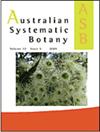A South American fossil relative of Phyllocladus: Huncocladus laubenfelsii gen. et sp. nov. (Podocarpaceae), from the early Eocene of Laguna del Hunco, Patagonia, Argentina
IF 1.6
3区 生物学
Q4 EVOLUTIONARY BIOLOGY
引用次数: 15
Abstract
Huncocladus laubenfelsii gen. et sp. nov. is described from the early Eocene (52 million years old) Laguna del Hunco site in Patagonia, Argentina, on the basis of a compression fossil with cuticle remains. The taxon has several similarities with Phyllocladus, together with characters that are absent in extant Phyllocladus species but are otherwise typical of the enclosing scale-leaved clade. Consequently, Huncocladus is interpreted as a relative of Phyllocladus, possibly belonging to its stem group. This view is supported by a phylogenetic analysis of Podocarpaceae, which recovers Huncocladus as sister to Phyllocladus within the here-termed phyllocladoid clade (Phyllocladus + Huncocladus). Huncocladus laubenfelsii is the first macrofossil record of the phyllocladoid lineage in South America or anywhere in the western hemisphere, vastly extending its historical range and constituting an additional lineage shared between Eocene Patagonia and extant and extinct Australasian and South-east Asian rainforests. The disappearance of phyllocladoids from South America adds to the general extinction pattern described previously for southern hemisphere Podocarpaceae, associated with the family’s low drought tolerance in the face of climate change (i.e. aridification). Huncocladus is the oldest record of the phyllocladoids, and it represents a new reference point for temporal calibration and biogeographic inference for the evolution of conifers and Australasian rainforests.laubenfelsii Huncocladus gen. et sp. 11 .是在阿根廷巴塔哥尼亚的始新世早期(5200万年前)的拉古纳亨科遗址发现的一种带有角皮残余的压缩化石。该分类群与叶根纲有若干相似之处,并具有现存叶根纲物种所没有的特征,但在其他方面却是叶根纲鳞片叶分支的典型特征。因此,Huncocladus被解释为Phyllocladus的近亲,可能属于其茎类。这一观点得到了podocarpacae的系统发育分析的支持,该分析恢复了Huncocladus作为Phyllocladus的姊妹,在这里被称为Phyllocladus (Phyllocladus + Huncocladus)。laubenfelsii Huncocladus laubenfelsii是南美洲或西半球任何地方的第一根枝类谱系的大化石记录,极大地扩展了其历史范围,并构成了始新世巴塔哥尼亚与现存和已灭绝的澳大拉西亚和东南亚热带雨林共享的额外谱系。南美叶根纲的消失增加了先前描述的南半球podocarpacae的普遍灭绝模式,这与该家族面对气候变化(即干旱化)的低耐旱性有关。Huncocladus是叶根纲最古老的记录,为针叶树和澳大利亚热带雨林的演化提供了时间定标和生物地理推断的新参考点。
本文章由计算机程序翻译,如有差异,请以英文原文为准。
求助全文
约1分钟内获得全文
求助全文
来源期刊

Australian Systematic Botany
生物-进化生物学
CiteScore
3.10
自引率
12.50%
发文量
12
审稿时长
>12 weeks
期刊介绍:
Australian Systematic Botany is an international journal devoted to the systematics, taxonomy, and related aspects of biogeography and evolution of all algae, fungi and plants, including fossils. Descriptive taxonomic papers should normally constitute a comprehensive treatment of a group. Short papers on individual species and nomenclatural papers must contain significant new information of broader interest to be considered. The prestigious L.A.S. Johnson Review Series is published. Other review articles will also be considered. All papers are peer reviewed.
Australian Systematic Botany is published with the endorsement of the Commonwealth Scientific and Industrial Research Organisation (CSIRO) and the Australian Academy of Science.
 求助内容:
求助内容: 应助结果提醒方式:
应助结果提醒方式:


